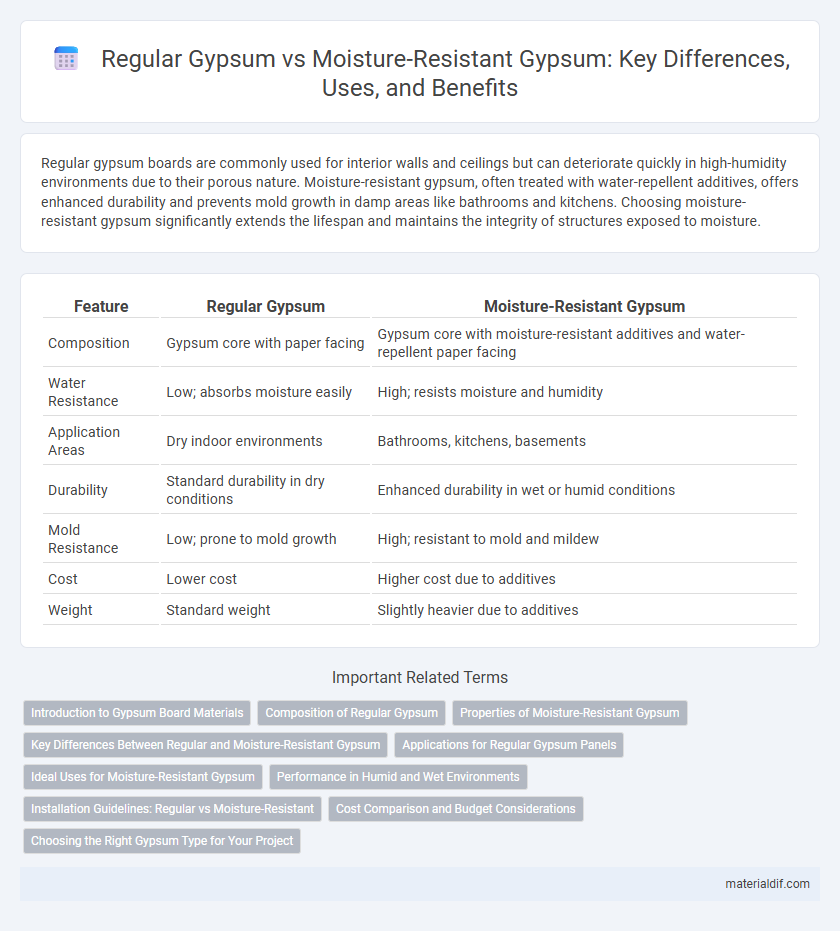Regular gypsum boards are commonly used for interior walls and ceilings but can deteriorate quickly in high-humidity environments due to their porous nature. Moisture-resistant gypsum, often treated with water-repellent additives, offers enhanced durability and prevents mold growth in damp areas like bathrooms and kitchens. Choosing moisture-resistant gypsum significantly extends the lifespan and maintains the integrity of structures exposed to moisture.
Table of Comparison
| Feature | Regular Gypsum | Moisture-Resistant Gypsum |
|---|---|---|
| Composition | Gypsum core with paper facing | Gypsum core with moisture-resistant additives and water-repellent paper facing |
| Water Resistance | Low; absorbs moisture easily | High; resists moisture and humidity |
| Application Areas | Dry indoor environments | Bathrooms, kitchens, basements |
| Durability | Standard durability in dry conditions | Enhanced durability in wet or humid conditions |
| Mold Resistance | Low; prone to mold growth | High; resistant to mold and mildew |
| Cost | Lower cost | Higher cost due to additives |
| Weight | Standard weight | Slightly heavier due to additives |
Introduction to Gypsum Board Materials
Gypsum board materials consist primarily of a core made from gypsum plaster sandwiched between paper facings, widely used in wall and ceiling construction. Regular gypsum boards provide standard fire resistance and sound insulation but are vulnerable to moisture and mold in damp environments. Moisture-resistant gypsum boards feature additives and coatings that inhibit water absorption, making them suitable for areas with high humidity such as bathrooms and kitchens.
Composition of Regular Gypsum
Regular gypsum primarily consists of calcium sulfate dihydrate (CaSO4*2H2O), which provides its characteristic hardness and fire-resistant properties. This composition makes it suitable for standard drywall applications but leaves it vulnerable to moisture damage and mold growth in damp environments. Unlike moisture-resistant gypsum, it lacks additives like fiberglass or water repellents that enhance durability against humidity.
Properties of Moisture-Resistant Gypsum
Moisture-resistant gypsum is engineered with additives like fiberglass and water-repellent agents, enhancing its durability against humidity and preventing mold growth. This type of gypsum board exhibits superior resistance to moisture absorption compared to regular gypsum, making it ideal for use in bathrooms, kitchens, and basements. Its high-density core and reinforced paper facing contribute to improved structural integrity and longer lifespan in damp environments.
Key Differences Between Regular and Moisture-Resistant Gypsum
Regular gypsum consists primarily of calcium sulfate dihydrate and is commonly used in dry interior applications, offering basic fire resistance and ease of installation. Moisture-resistant gypsum incorporates additives like fiberglass or silicone-based compounds, enhancing its ability to withstand humidity and resist mold growth, making it ideal for bathrooms and kitchens. Key differences include improved durability against moisture, specialized coatings for water repellency, and higher performance in wet environments for moisture-resistant gypsum compared to standard regular gypsum.
Applications for Regular Gypsum Panels
Regular gypsum panels are widely used in interior walls and ceilings where moisture exposure is minimal, such as living rooms, bedrooms, and hallways. These panels offer excellent fire resistance and soundproofing properties, making them suitable for residential and commercial buildings with standard indoor conditions. Their affordability and ease of installation contribute to their popularity in non-wet areas where moisture-resistant properties are not necessary.
Ideal Uses for Moisture-Resistant Gypsum
Moisture-resistant gypsum, often formulated with water-repellent additives and fiberglass mesh, is ideal for high-humidity environments such as bathrooms, kitchens, and basements. Its enhanced resistance to mold, mildew, and moisture damage makes it suitable for areas prone to condensation or water exposure. Unlike regular gypsum, which is more susceptible to moisture-related deterioration, moisture-resistant gypsum ensures durability and longevity in wet or damp settings.
Performance in Humid and Wet Environments
Regular gypsum boards offer standard performance suitable for dry indoor environments but tend to deteriorate rapidly in humid and wet conditions due to their porous core. Moisture-resistant gypsum boards incorporate water-repellent additives and specialized facings, significantly enhancing durability and preventing mold growth in high-humidity areas such as bathrooms and kitchens. The improved performance of moisture-resistant gypsum makes it essential for maintaining structural integrity and indoor air quality in moisture-prone settings.
Installation Guidelines: Regular vs Moisture-Resistant
Regular gypsum requires installation in dry environments to prevent deterioration and mold growth, making it ideal for interior walls and ceilings in low-humidity areas. Moisture-resistant gypsum contains additives that inhibit water absorption, allowing safe installation in high-humidity zones such as bathrooms and kitchens, ensuring durability and mold resistance. Proper sealing of joints and the use of moisture-resistant tape are essential for maintaining the integrity of moisture-resistant gypsum in wet conditions.
Cost Comparison and Budget Considerations
Regular gypsum is generally more cost-effective, with prices significantly lower than moisture-resistant gypsum, making it ideal for budget-conscious projects. Moisture-resistant gypsum, while pricier due to its enhanced water-repellent properties and durability in damp environments, offers long-term savings by reducing maintenance and replacement costs. Project planners should weigh initial material costs against potential future expenses when determining which gypsum type aligns best with their financial strategy.
Choosing the Right Gypsum Type for Your Project
Regular gypsum offers excellent fire resistance and smooth finishes ideal for interior walls and ceilings in dry environments, while moisture-resistant gypsum contains additives that prevent mold and deterioration in humid areas like bathrooms and kitchens. Selecting between them depends on exposure to moisture levels, where moisture-resistant gypsum ensures durability and longevity in wet spaces. Consider project requirements, environmental conditions, and local building codes to optimize performance and reduce maintenance costs.
Regular Gypsum vs Moisture-Resistant Gypsum Infographic

 materialdif.com
materialdif.com